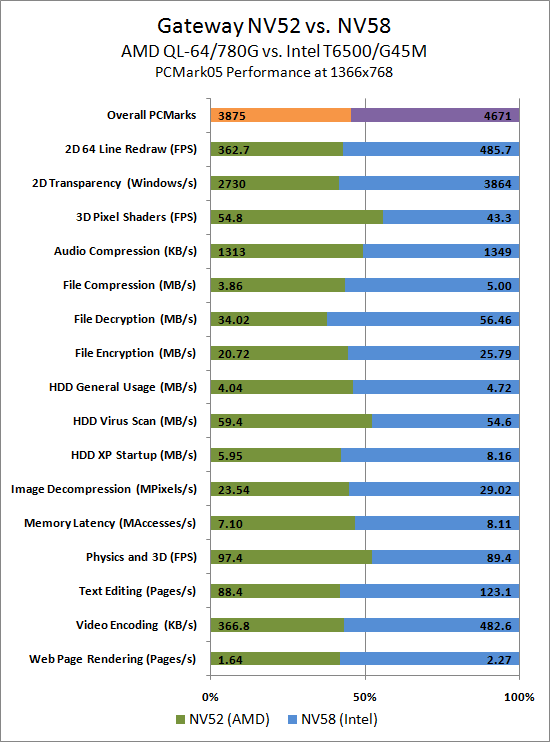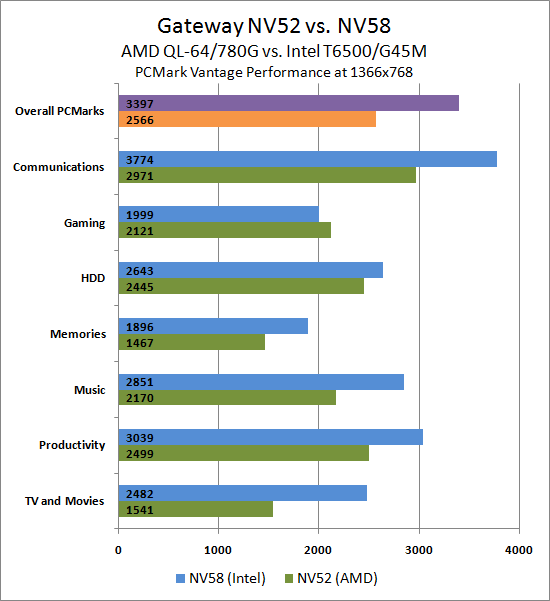Gateway AMD and Intel Laptops, a Platform Analysis
by Jarred Walton on August 12, 2009 2:00 AM EST- Posted in
- Laptops
PCMark Performance - AMD vs. Intel
Futuremark's method of determining composite scores in PCMark (and 3DMark) can be something of a mystery. Rather than taking the results at face value, we felt it would be more beneficial to show the individual scores for the various tests. We'll start with PCMark05, which is somewhat outdated relative to current software but also provides a more realistic look at how many people continue to use their computers (i.e. most people continue to use single-threaded applications more than multi-threaded applications).

In PCMark05, the Intel system ends up 20.5% faster in the overall metric, but individual scores range from Intel leading by 66% (File Encryption) to AMD leading by 26% (3D Pixel Shaders). A couple other important metrics are Web Page Rendering, HDD XP Startup, and HDD General Usage. These are all common situations that you encounter any time you use a computer, and Intel leads by 38%, 37%, and 17% in these tests, respectively. During testing, it was obvious that the Intel system was substantially faster in general use. Booting both systems, it would always finish loading Windows noticeably faster, and when we ran a disk defragment on both systems after installing all of the test software the AMD system took hours longer to finish.
It should be clear why the AMD system wins in the Physics and 3D (9%) and 3D Pixel Shaders (26%) tests. What's not so clear is why AMD would win in the HDD Virus Scan (8%) result, and the likely culprit is the Seagate hard drive is faster than the Hitachi HDD in the NV58 in this specific test. It's also important to remember that individual scores can fluctuate quite a bit between runs on PCMark05 - up to 12% between the various runs we conducted on these two laptops. The overall scores on the other hand remain relatively consistent. Let's move on to PCMark Vantage and see if the picture changes at all.

This time the Intel system is 32% faster in the composite score, with individual scores ranging from 6% in AMD's favor to 61% in Intel's favor. Again, AMD takes the Gaming crown, although as we shall see shortly the 6% margin of victory is highly suspect when we get to actual games. Outside of the HDD test - a test that logically focuses more on the hard drive than the rest of the system - Intel maintains a comfortable lead of 20% or more.
The short story to this point is that not only does the Intel system provide substantially better battery life, it also provides a much snappier user experience. If all you're looking for is a typical office computer, the extra $80 you spend for the NV58 is definitely a worthwhile investment compared to the NV52. There is still the question of graphics, of course, so let's look at the last area and consider how much gaming performance matters in your laptop purchasing decision.
Update
Here's an alternate chart for PCMark Vantage showing relative performance. Given the disparity in scores for PCMark05, we didn't bother creating this style of chart.











67 Comments
View All Comments
7Enigma - Wednesday, August 12, 2009 - link
Agreed. People are not going to be gaming on the latest (or even last-gen FPS') but most certainly would probably be doing MMO games. And of all the games The Sims (2 or 3) should be included. That is probably the largest non-MMO game out there for the casual gamer, of which these laptops are perfectly suited.KidneyBean - Wednesday, August 12, 2009 - link
Or how about Source games like Half-Life 2, Team Fortress 2, and Counter-Strike 2?Those should run faster than the latest FPS.
hyc - Wednesday, August 12, 2009 - link
Very few vendors actually sell comparable models of AMD and Intel notebooks. I don't think HP's dv5z (which I own, and is already discontinued) is really comparable to their dv5t.And I've yet to find anyone selling an AMD laptop with 15.4" WUXGA screen. So far the only possibilities have been Dell or Lenovo, and they're all Intel. It's pathetic that AMD has the best graphics cards now but you can't get an AMD combo paired with the best screens.
Show me an AMD notebook with 15.4" WUXGA LED-backlit screen. (Oh, and backlit keyboard too, please.) I'll buy it. I'm sick of seeing AMD designs getting the poor cousin treatment, I want all the same top notch feature choices the Intel models get...
strikeback03 - Thursday, August 13, 2009 - link
You realize you can get an AMD discrete GPU with an Intel CPU/chipset, right? Which this article has shown that the GPU is really the only part of the AMD system worth owning.cactusdog - Wednesday, August 12, 2009 - link
Nice review, it answered some questions i had.cfaalm - Wednesday, August 12, 2009 - link
Talking about a price premium over a $ 500 - 580 notebook:
damianrobertjones - Wednesday, August 12, 2009 - link
Or if Dailytech really isn't one sided towards Apple, then maybe the reviewer could also add a Linux build to the scene.. Standard laptop, linux.. what would the battery life be?????hyc - Wednesday, August 12, 2009 - link
Likely worse on the AMD system. At least, the open source ATI drivers' support for power management still doesn't handle all of the power save features that the chipset offers.medi01 - Wednesday, August 12, 2009 - link
Why not compare to intel notebook with nvidia graphic card?samspqr - Wednesday, August 12, 2009 - link
the labels on the x axis of the power consumption graph are completely deceiving